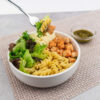Healthy Easter: Tips from a Dietitian
The Easter period, like many other holidays, is often associated with large feasts. However, during family and friend gatherings, it’s easy to lose sight of moderation, which can be taxing on our bodies. We asked a nutrition expert about this year’s trends, changes in our dietary habits, and of course, the ideal Easter diet.
An Easter table is incomplete without ham and eggs, accompanied by “mandatory” sweet bread and, of course, increased chocolate consumption, not to mention cakes. However, in recent years, more sustainable diets that include more vegetables and other plant-based foods have come to the forefront. To navigate through various diets, we turned to Kinga Shenker-Horváth, dietitian at Eisberg, to guide us.
In this article, we explore how salads can be harmoniously integrated into the Easter menu, not only complementing but also enhancing traditional dishes. Whether it’s a simple green salad to add freshness alongside the ham, or a more complex, richer salad recipe that can stand on its own. Another goal is to highlight the importance of incorporating healthy, fresh vegetables on the holiday table. Additionally, we aim to inspire readers to make their Easter diet more varied and colorful with Eisberg salads.
“Recent surveys on Hungary’s population show that much of their fat intake comes from animal fats, and meat and processed meats play a significant role in their diet,” says Kinga Shenker-Horváth. “However, it’s important to emphasize that there is a growing trend towards plant-based diets, with an increasing number of people adopting vegetarian diets. It’s also important to point out that according to the Healthy Plate nutrition recommendations by the Hungarian Dietetic Association (MDOSZ), many people still don’t reach the recommended daily intake of at least five servings of vegetables and fruits.”
The nutrition expert stressed that this cannot be achieved overnight, but even small changes can greatly improve our health, such as incorporating salads, various vegetables, and fruits into our daily diet.
“When it comes to salads, we aim to increase awareness of the various types available,” said Kinga Shenker-Horváth. “It’s not just about iceberg lettuce and head lettuce; there are many varieties worth experimenting with, such as arugula, lamb’s lettuce, endive, radicchio, baby spinach, and curly kale. These can help diversify our vegetable intake.”
The dietitian also emphasized that even those who follow an omnivorous diet (i.e., consume meat) can incorporate meat-free days into their weekly diet.
“By introducing meat-free days, we’re doing something good for both our health and the planet. With plant-based protein sources, we can still get the right amount of protein, for example, by making salads that include legumes (such as lentils, beans, and peas), nuts (such as walnuts, almonds, hazelnuts, pistachios), and/or grains (such as oats, durum wheat pasta, millet, or barley). The key is that every small step counts because our diet is not black and white, it’s colorful, just like salad bowls.”
Kinga Shenker-Horváth also pointed out that we can increase our vegetable intake by adding steamed vegetables and pickles, but the best option is still fresh, raw vegetables and fruits, with at least 3 servings of vegetables and 2 servings of fruits in the recommended 5 servings per day.
During the Easter period, it’s easy to find fresh, seasonal vegetables, which many look forward to after the winter months. The expert highlights that seasonal eating is both financially beneficial and environmentally sustainable, and that seasonal produce offers the highest nutritional value compared to out-of-season, artificially ripened vegetables or fruits.
In summary, even during Easter, we should aim to eat as variably as possible while enjoying the holiday’s delights. Let’s allocate more space for vegetables – for example, instead of ham, we can wrap the filling in salad leaves. Pay attention to seasonality and don’t be afraid to try new things. And for creating rich and flavorful Easter salads, you can always find high-quality, ready-to-use pre-packaged Eisberg salads in stores, saving you time and adding color to your festive diet.



